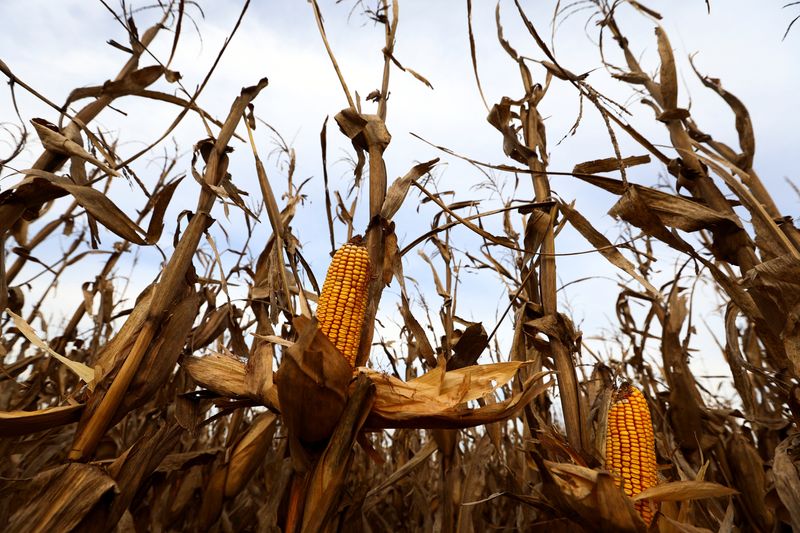Commodities
Gold bulls eye more record highs despite lightning gains

By Polina Devitt
LONDON (Reuters) -An upgraded gold price forecast for 2024 from Nicky Shiels, head of metals strategy at Swiss gold refinery MKS PAMP, drew an unexpected follow-up question this week from market participants. The enquiry was: “Will or can gold ‘go cocoa’?”
Cocoa prices have more than doubled since the start of 2024 due to poor harvests in Ivory Coast and Ghana.
Meanwhile, , a much more global and liquid market, hit record highs on five previous trading sessions as investors jumped in looking for exposure to the metal used to preserve wealth.
Gold’s record high at $2,305.04 an ounce hit on Thursday amounts to a gain of 12% since the start of the year.
“There is almost zero probability gold can replicate those gains in that amount of time,” Shiels said.
While cocoa price growth is driven by supply shortage, the gold market is protected by significant stocks held by individuals and reserves of central banks, which own one-fifth of all the gold ever mined.
“One cannot de-stock chocolate bars at the same rate as one can de-stock gold bars,” she said. Her forecast for the 2024 average gold price was raised by $150 to $2,200 an ounce.
However, while the market may not exactly “go cocoa”, analysts retain a bullish tone even as technically the market feels ripe for hefty falls due to it being overbought.
“It is hard to say where values are going to top out as there are no resistance “signposts” on the charts,” said Marex analyst, Edward Meir.
Gold’s April rally came on top of its 9.3% jump in March, the strongest since July 2020, which unfolded despite traditional macro headwinds such as a strong dollar and elevated U.S. real interest rates.
Over-the-counter and futures gold markets have been buoyant, with an estimated 40% rise in trading volumes, said Johan Palmberg, senior quantitative analyst at the World Gold Council.
“And there is outsized activity in the gold options market, in comparison with the likes of equities and bonds, which implies that the current interest is specifically in gold.”

Further out, many analysts expect gold to test new highs once the U.S. Federal Reserve starts cutting key rates triggering demand from investors sitting on the sidelines such as holders of physically-backed gold exchange traded funds (ETFs).
“We had previously proposed a $2,400 per ounce price estimate if the Fed cut rates in the first quarter of 2024; we commit to that estimate for this year, even if rate cuts come later,” analysts at BofA said in a note.
Commodities
As climate shifts, a leafhopper bug plagues Argentina’s corn fields

By Maximilian Heath and Matias Baglietto
CORDOBA PROVINCE, Argentina (Reuters) – Global warming has brought Argentina’s corn farmers a dangerous new enemy: a yellow insect just four millimeters (0.16 inch) long that thrives in hotter temperatures and is threatening harvests of the crop. Meet the leafhopper.
The world’s No. 3 corn exporting country has slashed millions of tons from its harvest projections for the current crop due to a rare plague of the insect that can carry a stunt disease that damages the cobs and kernels of the plant.
Farmers fear such infestations could become more regular, with fewer frosts in recent years to check the insect’s spread, and forecasts for a warm winter ahead, farmers, weather experts and data analyzed by Reuters showed.
Some farmers already have said they will sow less corn for next season in favor of other crops such as soy, the South American country’s main cash crop, which is not affected by the bugs.
“Many are going to reduce their hectares of corn to zero,” said Anibal Cordoba, a producer in northern Chaco province, adding a hard freeze this winter is needed or leafhopper numbers will explode again next season.
“You normally found leafhoppers in the bud of the plants if you looked. But this year you go to the field and you find clouds of leafhopper. It’s just crazy.”
Agriculture and climate experts linked the unusual outbreak to rising global and local temperatures.
“The number of days with frost is becoming less frequent due to global temperatures rising,” said climate change specialist Matilde Rusticucci at the University of Buenos Aires, adding minimum temperatures in the country had “increased steadily”.
remove ads
.
“The year 2023 was declared the warmest year in history,” Rusticucci said. This helped leafhoppers spread far beyond the warmer northern regions where they usually thrive and where farmers have adapted. Some 10 million tons of Argentine corn production has been lost already, and analysts say it could fall further.
“We should be talking about an Argentine production of more than 60 million tons of corn and because of this insect we are talking about 50.5 (million tons),” said Cristian Russo, head of agricultural estimates at the Rosario grains exchange (BCR).
“We all suspect that it still could get much worse than what we’re seeing,” he added. “It’s a big blow to corn.”
According to Russo, leafhopper numbers in northern Argentina are 10 times the normal level, while the insect has been found nearly 1,500 kilometers (932 miles) south of traditional areas, where previously it had been too cold.
Argentina’s government, which did not respond to a request for comment on this story, has looked to speed authorization for pesticides to fight leafhoppers and recently met with farm associations to coordinate how to mitigate leafhopper damage.
‘THIS IS A REAL, REAL PROBLEM’
In parts of Argentina, frosts have actually increased in recent winters, but some key farming areas have had a substantial decline. Nationally, minimum temperatures have been rising and cold nights decreasing over decades.
A study by scientists at Argentine universities and state institutes showed that from 1963 to 2013 the average number of cold nights decreased from 15 days per year to around eight.
remove ads
.
Fewer frosty nights help leafhoppers, which cannot tolerate temperatures below 4 degrees Celsius, said Fernando Flores, entomologist at the National Institute of Agricultural Technology (INTA).
“One of the most important causes of the big increase in (insect) numbers was the decrease in the number of frosts in the country the previous winter,” Flores said.
In western central Cordoba province, the main corn region of Argentina, the provincial grain exchange has estimated leafhopper-related corn losses of $1.13 billion. Data from the Cordoba observatory show frosts down steadily over decades.
“What was planted late towards the end of December, beginning of January, was where the greatest damage was seen,” said Ramón Garcia, a farmer from the Cordoba farm town of Marcos Juarez. “There was a significant drop in yield.”
The outlook ahead is tough. Rusticucci said January, February and March 2024 already set records for global maximum temperatures.
Michael Cordonnier, Illinois-based agronomist at consultancy Soybean and Corn Advisor Inc, said what had happened with corn in Argentina was “very unusual” and it would take time for farmers there to adapt, as farmers in warmer corn-growing areas like Brazil have adapted over years.
“This is a real, real problem. Going forward, they will be able to solve this a few years down the road by getting hybrids that are more tolerant to corn stunt disease and registering more insecticides for this specific problem,” he said.
“But for the time being it’s just terrible.”
Commodities
Oil steadies as weak physical markets balance Middle East tensions

By Alex Lawler and Deep Kaushik Vakil
LONDON (Reuters) -Oil steadied on Tuesday as weakness in the physical market countered concern about conflict in the Middle East as Israel stepped up attacks in southern Gaza and a ceasefire deal between Hamas and Israel hung in the balance.
The Israeli military seized control of the Rafah border crossing between the Gaza Strip and Egypt and its tanks pushed into the southern Gazan town of Rafah, as mediators struggled to secure a ceasefire agreement.
futures were down 30 cents, or 0.4%, at $83.03 a barrel by 1130 GMT while U.S. West Texas Intermediate (WTI) crude futures fell 27 cents, or 0.3%, to $78.21.
“Truce remains elusive, and even if it is reached the question remains whether Houthi hostilities in the Red Sea would cease and the Suez Canal would reopen, significantly mitigating the risk of shipping throughout the region,” said Tamas Varga of oil broker PVM.
“I believe the lack of optimism of the past few days is more the result of genuine weakness in the physical markets.”
In a sign of easing concern that supply could tighten, the first-month Brent contract’s premium to the six-month contract slipped to $2.89 a barrel for its lowest since mid-February.
“Trying to use geopolitics as an excuse to buy crude oil has become an increasingly futile and costly affair for traders in recent months,” said Ole Hansen of Saxo Bank, adding that the drop in crude spreads highlights “a well supplied market, leaving the upside capped for now”.
remove ads
.
Last week Brent and WTI had registered their steepest weekly losses in three months as the market focused on weak U.S. jobs data and the possible timing of a Federal Reserve interest rate cut.
A stronger dollar also weighed, making crude more expensive for traders holding other currencies.
As well as Middle East tensions, the latest U.S. inventory reports will also be in focus.
oil and product stockpiles were expected to have fallen last week, a Reuters poll showed. Crude inventories could have fallen by about 1.2 million barrels in the week to May 3, based on analyst forecasts. [EIA/S]
Saudi Arabia’s move to raise official selling prices for its crude sold to Asia, Northwest Europe and the Mediterranean in June also supported prices, signalling expectations of strong demand this summer.
Commodities
Oil prices slip lower; Israel-Hamas ceasefire talks, US inventories in focus

Investing.com– Oil prices edged lower Wednesday amid uncertainty over global production as a potential Middle East ceasefire hangs in the balance.
At 08:40 ET (12:40 GMT), fell 0.5% to $82.91 a barrel, while dropped 0.6% to $78.04 a barrel.
Israel-Hamas ceasefire deal remains elusive
Palestinian militant group Hamas on Monday agreed to a Gaza ceasefire proposal from mediators, but Israel said the terms did not meet its demands and undertook strikes on the city of Rafah, in southern Gaza.
While Israel was still seen preparing for ceasefire negotiations later, the recent escalation in military action showed little actual progress towards a deal.
A lack of settlement between the parties in the now seven-month long conflict has supported oil prices, as investors worry regional escalation of the war will disrupt Middle Eastern crude supplies.
That said, little actual disruption has been seen to date, and the benchmarks posted the steepest weekly losses in three months last week as investors worried about the prospect of higher-for-longer interest rates curbing growth in the U.S., the top global oil consumer.
Russia to agree to lift production?
The market has edged lower Tuesday after news reports said Russian Deputy Prime Minister Alexander Novak indicated OPEC+ could move to raise crude production.
The Organization of the Petroleum Exporting Countries and allies, known as OPEC+, are making voluntary output cuts totalling about 2.2 million barrels per day for the first half of 2024, on top of earlier reductions announced in various steps since late 2022, bringing the total pledged cuts to just under 6 million barrels per day.
remove ads
.
Bloomberg reported Monday that Russia’s oil and gas revenues doubled in April despite sanctions, creating room for Moscow to agree raise output, even is prices suffer as a consequence.
OPEC+ is scheduled to meet on June 1 in Vienna to decide its next output policy steps.
US inventories data due
As well as Middle East tensions, the latest U.S. inventory reports will also be in focus Tuesday.
The releases its weekly forecasts of U.S. crude oil and product stockpiles later in the session, and these are expected to have fallen.
stockpiles sprung a surprise increase the previous week, the API reported last week, with inventories rising by about 4.9 million barrels for the week ended April 26.
The Energy Information Administration will also publish its latest later in the session, which will include the EIA’s latest views on the global oil market, and its latest forecast for U.S. oil and gas production for the remainder of this year and 2025.
(Ambar Warrick contributed to this article.)

 Forex2 years ago
Forex2 years agoForex Today: the dollar is gaining strength amid gloomy sentiment at the start of the Fed’s week

 Forex2 years ago
Forex2 years agoHow is the Australian dollar doing today?

 Forex1 year ago
Forex1 year agoUnbiased review of Pocket Option broker

 Forex2 years ago
Forex2 years agoDollar to pound sterling exchange rate today: Pound plummeted to its lowest since 1985

 Cryptocurrency2 years ago
Cryptocurrency2 years agoWhat happened in the crypto market – current events today

 World2 years ago
World2 years agoWhy are modern video games an art form?

 Stock Markets2 years ago
Stock Markets2 years agoMorgan Stanley: bear market rally to continue

 Economy2 years ago
Economy2 years agoCrude oil tankers double in price due to EU anti-Russian sanctions

































